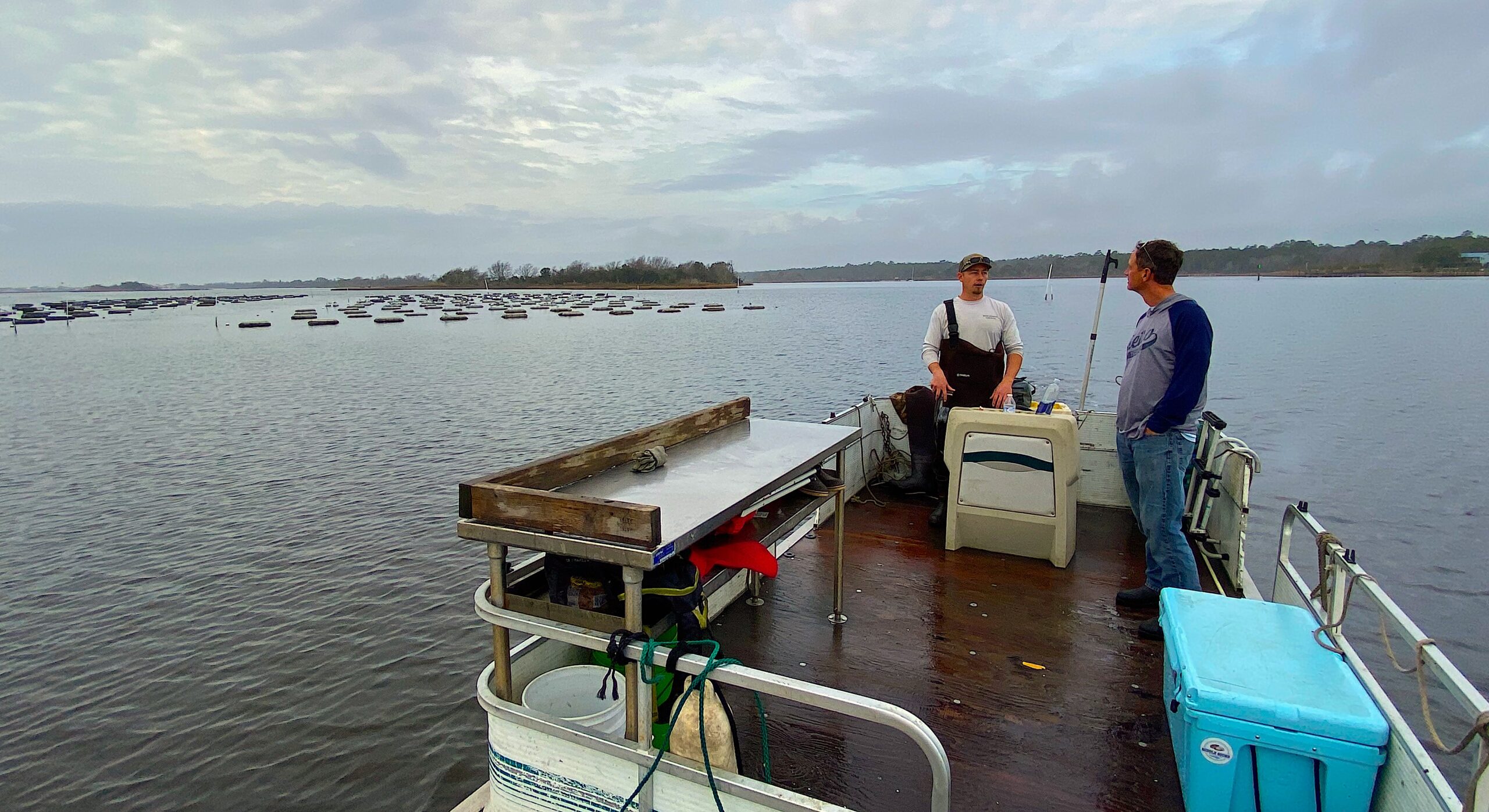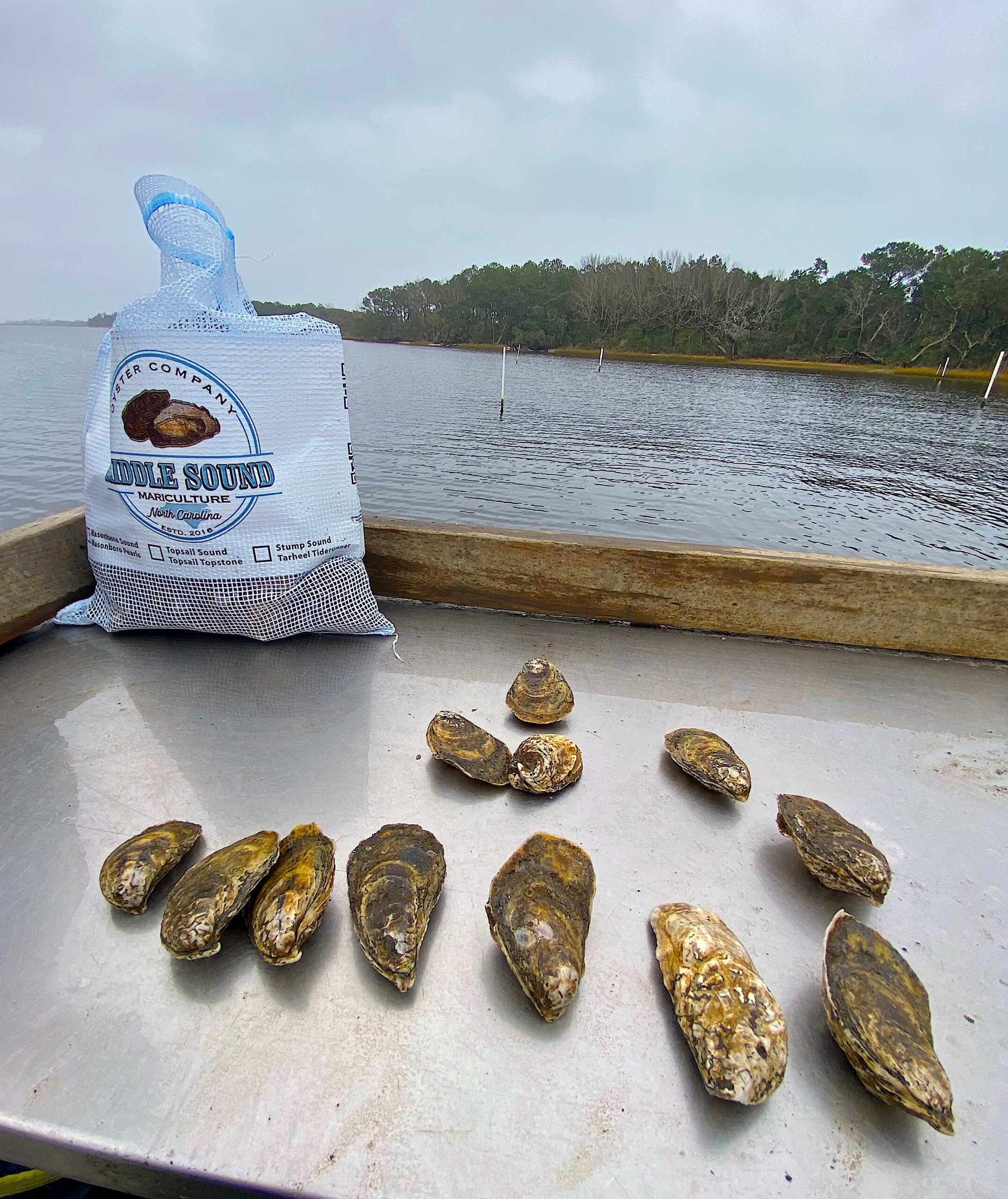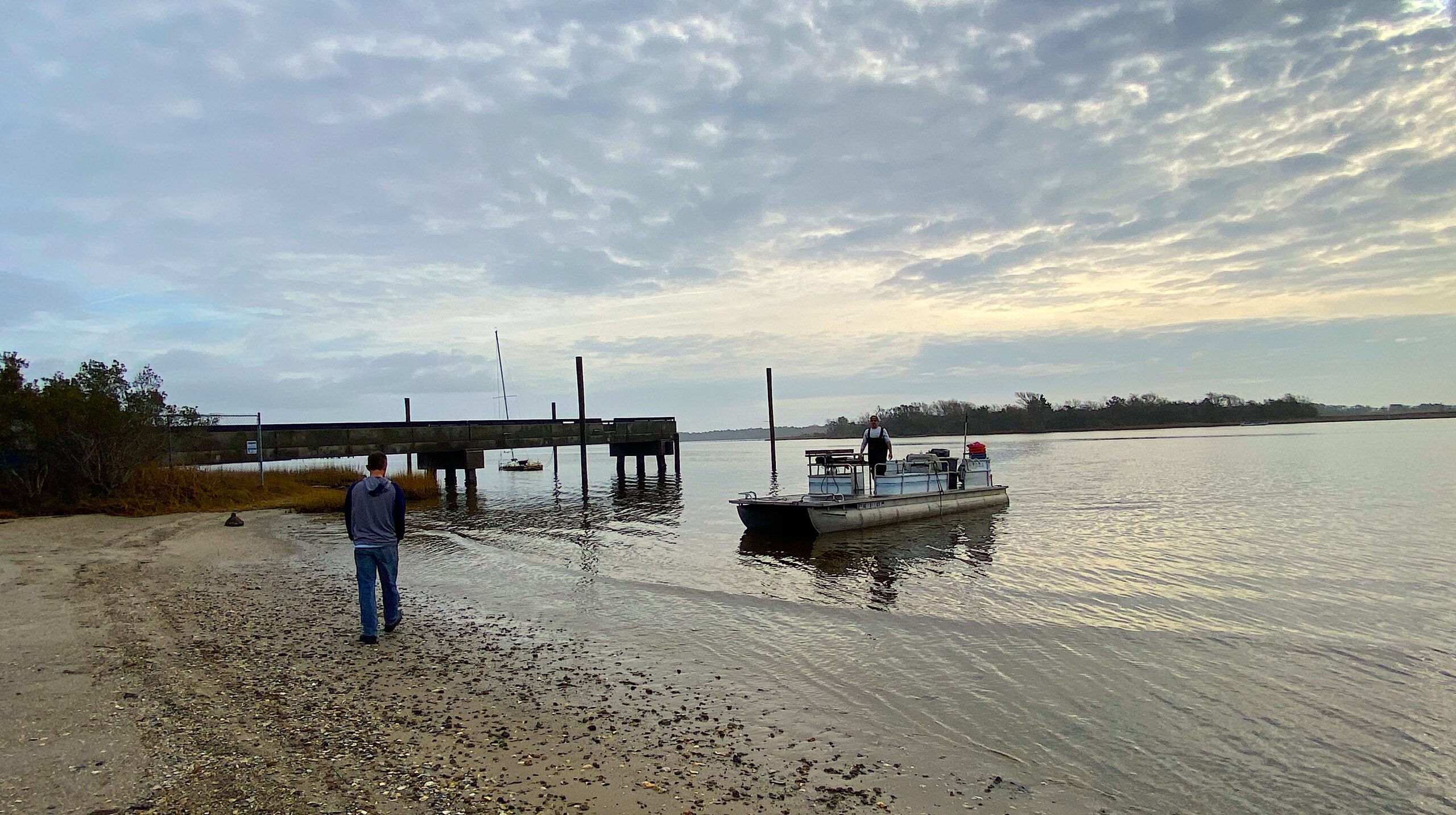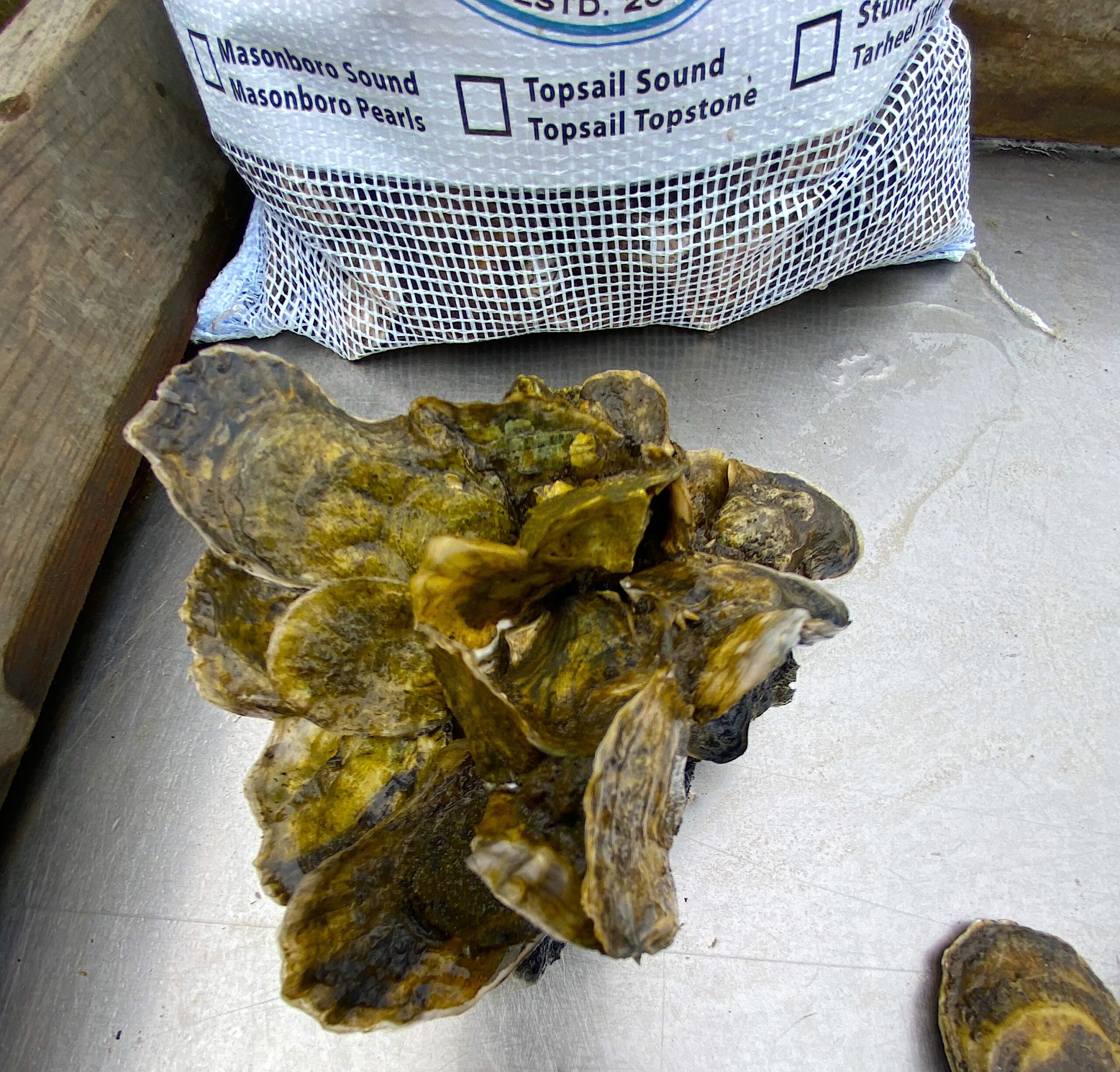
My husband and I are all about giving experiences for birthday gifts, so when Toby’s 50th crept up — I knew it had to be unique, memorable and juicy. COVID-19 put some legit limitations on what was even possible — so I had to go deep to come up with something that would fit the bill. In the end, I found the perfect maritime adventure right here in North Carolina that would help us both up our shell game.
Oysters and the adventurous gastro trend that goes along with eating one of the only foods consumed while it is still alive(!), are having a moment. And, I discovered that we are lucky enough to be living in an area that some are calling the Napa Valley of Oysters. Who knew there was such a thing as the North Carolina Oyster Trail? Some quick googling and you too will learn that after years of over-farming wild oysters, there’s an Oyster Renaissance in the South for local farming. I knew Toby would love to start his oyster education right here at the source. We were both super excited to “go where they grow.”
I reached out to James Hargrove, owner-operator of Middlesound Mariculture, who is not only an oyster farmer. He is a legit oyster scientist — and happens to be a real nice guy.
We soon learned why you have to be a bit of an oyster nerd to be at all successful in this venture. James has been involved in the burgeoning N.C. oyster farm business from almost the inception of the area’s industry boom several years back. He knows all the stories and has been there for all the bumps and growing pains. He has even done his part to help pave the way for new farmers.
 A UNCW graduate with a master’s in marine science, James has been waders-deep — like literally chest high — in oysters for over a decade. He sells his oysters through a large N.C. distributer, Locals Seafood, and to local restaurants around the Triangle and Outer Banks. Several restaurants in Wilmington, including Wrightsville Beach Brewery, Pinpoint and Tidewater Oyster Bar, are just a few that feature his oysters — and Toby and I will definitely be requesting them by name from now on.
A UNCW graduate with a master’s in marine science, James has been waders-deep — like literally chest high — in oysters for over a decade. He sells his oysters through a large N.C. distributer, Locals Seafood, and to local restaurants around the Triangle and Outer Banks. Several restaurants in Wilmington, including Wrightsville Beach Brewery, Pinpoint and Tidewater Oyster Bar, are just a few that feature his oysters — and Toby and I will definitely be requesting them by name from now on.
Currently, Middlesound holds leases for three oyster farms, one of the largest located in the waters at Stump Sound, near the beautiful Permuda Island National Estuarine Research Reserve up near Topsail Beach. That’s the one we visited, and it’s where their award-winning Tarheel Tiderunner oysters are harvested. I don’t know if they have actually won any awards, but Toby and I would totally give them one.
James picked us up on his modest oyster boat at the end of Morris Landing Road in Holly Ridge, just about 40 minutes north from our home in Wilmington. It was basically a pontoon boat with a big flat deck, a cooler and a stainless-steel table. It was rugged but clean. He greeted us with a huge friendly smile, and I knew we were in for a great experience.
We were about to see and taste where the magic happens. James is so passionate about his work and eager to get the word out about N.C.’s growing oyster trade and delicious oysters. He is super smart and gave us an incredibly generous behind-the-scenes tour of local oyster farming in North Carolina, which we learned — much like eating the thick-shelled, algae siphoning bivalve — is not for the faint of heart.
Oyster farming is super physical, hands-on work, and at this early stage of the industry, it requires an incredible amount of tenacity to work through all the government and environmental regulations and lease laws — which seemingly change with the tides. Add in the other natural challenges like barnacles, harmless but menacing mud worms that mess up ideal shells, unpredictable tides, other marine life (like the lucky little crab that found his way inside an oyster cage and enjoyed a full oyster raw bar, cleaning out an entire crop of oysters!), and hurricanes, and you will have a real appreciation for what it takes to get locally-sourced oysters to the table.
 He explained to us how before a hurricane, they’ll “sink” the farms — so that the lines don’t get carried away with rough currents — but that sometimes this results in the need to reach down in the water and blindly untangle hundreds of feet of muddy submerged lines after a storm, many hours of work. This farming business is tons of science and even more trial and error. James shared stories of costly, heartbreaking learning curves that have ultimately helped him to be a better oyster harvester. From hatchery to restaurant, oysters are handled maybe a hundred times. This is no “set it and forget it” harvest. Truly, it’s a hands-on, labor of love.
He explained to us how before a hurricane, they’ll “sink” the farms — so that the lines don’t get carried away with rough currents — but that sometimes this results in the need to reach down in the water and blindly untangle hundreds of feet of muddy submerged lines after a storm, many hours of work. This farming business is tons of science and even more trial and error. James shared stories of costly, heartbreaking learning curves that have ultimately helped him to be a better oyster harvester. From hatchery to restaurant, oysters are handled maybe a hundred times. This is no “set it and forget it” harvest. Truly, it’s a hands-on, labor of love.
On our tour, we explored a few of his oyster beds, checked out the gear, cages and lines, and learned about the waterways and our beautiful surroundings. A few of his employees were already out on the farms sorting and separating larger, mature oysters on a processing boat while we checked in on some of the oyster cages in the water. James hopped off of the boat into the shallow water and pulled a cage off the line and onto the deck. Then he poured out the contents onto the stainless-steel table for us to inspect.
This was it! Oyster farming directly at the source.
We checked out the progress of oyster seeds that come from the only hatchery in the state. They were now about an inch big, and James seemed pleased with their shape and growth. Oysters can take 2 to 3 years to grow and be ready for harvest.
 The Middlesound Mariculture farms use multiple oyster farming methods, such as adjustable longline, bottom trays and floating cage methods. These methods help to ensure oysters are lifted up into the water column where they can filter plenty of algae and natural waves help to give them the perfect rounded shell shape. James has his own idea of the perfect oyster: about 3” long by 2” wide and about 1” deep.
The Middlesound Mariculture farms use multiple oyster farming methods, such as adjustable longline, bottom trays and floating cage methods. These methods help to ensure oysters are lifted up into the water column where they can filter plenty of algae and natural waves help to give them the perfect rounded shell shape. James has his own idea of the perfect oyster: about 3” long by 2” wide and about 1” deep.
There was so much to learn about oysters from the environmental science — how they leave the waterways even cleaner, with a single oyster filtering 50 gallons of water each day to the culinary profiles behind each harvest. James explained how the salinity from the inlets create really unique flavor profiles for all his oysters. Similar to wine tasting, connoisseurs discuss the salinity, complexities and the finish. Some common tastes found in oysters include cucumber, seaweed, mineral, iron, lettuce, and mushroom — but he says that generally people get most excited about their oysters being salty.
Our tour wouldn’t have been complete without our own sampling of those Tarheel Tiderunners. James grounded us in a picturesque spot among some wild oysters along the shore, and he then poured some freshly harvested oysters out of a Middlesound Mariculture-branded mesh sack that was in the onboard cooler. He grabbed a “rock” and skillfully began shucking.
For our first taste, Toby and I showed our appreciation by slurping them down raw without the hot sauce and lemon that he had put out on the table for us. The oysters were salty, buttery and really meaty. I felt like I ate the ocean. I enjoyed my oyster more than any I had ever consumed at a restaurant — not because it tasted better, but because I now truly appreciated the journey and the love put into these salty, protein bomb miracles. For my second oyster, I added the hot sauce and lemon and I really loved the taste even more.
Toby went back and forth between slurping them down straight away and taking the 5 seconds to squeeze lemon and shake on the sauce. We let James shuck several more for each of us, and a few more for Toby, and then James slurped back a few for himself, too — proof, perhaps, that it’s not work if you are doing what you love.
Thanks, James Hargrove and Middlesound Mariculture, for an experience that we will both not only remember, but one that we will keep alive as we continue to explore the N.C. Oyster Trail — because, as you know, the world is our oyster!
You can check out James Hargrove and Middlesound Mariculture in this video or follow them on their social media accounts on Instagram and on Facebook.
photos courtesy of Gina Daschbach